Italian baroque mandolin sonatas
ARTEMANDOLINE
Italian baroque mandolin sonatas
The 18th century was the golden age of the mandolin. The ensemble Artemandoline presents world premiere recordings of forgotten masterpieces written in Florence and Rome for mandolin and basso continuo. A music full of energy, beauty and virtuosity.
Works by: Susier, Romaldi, Trento, Piccone, Capponi
Performers: 6/7 musicians
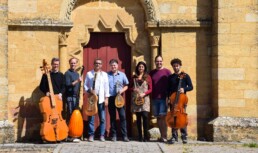
The works that are featured on the present disc were all written during an extremely fertile period in the history of the mandolin. The inventive inquisitiveness of Baroque musicians took them in the direction of the subtlest of sonorities, and no sound was more subtle than that of the mandolin.
This brings us to the end of our fascinating exploration of the world of the Italian Baroque. The works by Capponi, Romaldi and Susier have long been familiar to the Baroque ensemble Artemandoline, and their performances come up to the very highest expectations.
This unpublished music has been overshadowed for far too long but will impress its present-day listeners with its blend of grandeur and charm, qualities that its performers have brought to light to perfection.
This ambitious program is magnificently interpreted and well calculated to seduce its listeners. The Italian sonata constitutes an independent genre in the musical life of this period and quickly became an integral part of court entertainments in the palaces of the peninsula.
Critique
[...] la soprano Nuria Rial apporte une grande habileté et un charme impétueux dans ces arias, elle chante cette musique avec style en parfaite osmose avec les mandolines pour créer des dialogues enchanteurs. Tout au long, les musiciens d'Artemandoline interprètent cette musique avec élan et sympathie, en parfaite connivence, un enchantement [...]
Robert Hugill, Planethugill
Alla Ciaccona
Artemandoline & Meike Herzig, recorder
Alla Ciaccona
Balli & ciaccone
« Alla Ciaccona » is a program prepared by the musicians of ’Artemandoline and the recorder player Meike Herzig to explore all the sonorous and technical aspects that the recorder and the mandolin have to offer.
Works by: Falconieri, Capricornus, Uccellini, Caroso, Susier...
Performers: 6 musicians & Meike Herzig, recorder
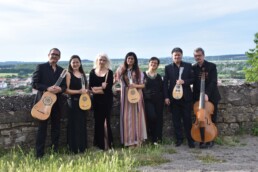
Upon a ground, and other ostinatos, standards in the 18th century musical repertoires, the performers challenge is to combine their inspiration and their creativity in their way of playing enabling them to showcase their virtuosity while competing in ingenuity.
The passionate outbursts of Italian music can be found in this program mixing improvisation with the experimental.
The contrast of soft, smooth melodies with brilliant passages full of impetuosity leave the listener amazed and surprised. The typical ambivalence of the alternating binary /ternary of the basso allows the performer to be more flexible in interpretation and form.
A journey full of surprises led by lively, colorful and varied music taking the listener along the pathways of the Italian musicians in their search for both a soft smoothness and expressive force.
REVIEW
[...] Artemandoline is distinguished by its harmonic turns, for the many ornamental details and by its great melodic ingenuity [...]
Toda la Música, Madrid
A perfume of Italy
Artemandoline & Lucie Horsch, recorder
A perfume of Italy
Concerti e sonate
During the baroque period concertos ad sonatas for mandolin and recorder were very popular as shown by the many manuscripts collected in European libraries.
In the programme « Perfume of Italy » the scene is set as soon as the first notes are played, the music overwhelms us, we are enthralled, engulfed by the vertiginous passages of the mandolins and the recorder. An insolent liberty is taken, velocity, virtuosity….
Works by: Cima, Leo, Sammartini, Vivaldi, Arrigoni…
Performers: 6/7 musicians & Lucie Horsch
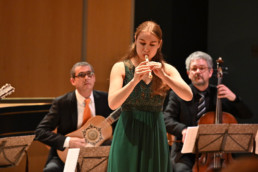
With their ensemble Artemandoline, Juan Carlos Muñoz and Mari Fe Pavón offer the public the opportunity to discover the still widely unknown repertoire of the baroque mandolin.
They have teamed up with the young Dutch musician Lucie Horsch, whose extraordinary talent has made her one of the most requested recorder players in the world.
Together they have prepared an extremely expressive and emotionally rich program with works by Italian baroque composers including Antonio Vivaldi for whom Lucie Horsch has a special affection.
A repertoire full of energy: a hymn to emotions.
REVIEW
[...] Artemandoline exuberantly reproduces the final splendors of Neapolitan instrumental music from the baroque era … the ornamentation is abounding in refined and lush detail. Such lambent, vibrant colours! [...]
Fabienne Bouvet, Classica
Venice's Fragrance
ARTEMANDOLINE & NURIA RIAL
Venice's Fragrance
Venetian splendors
Venice and music is a story of masks and orphans. Musical treasures are often full of surprises. The voice and the instruments especially the mandolin compete with charm and impetuosity to conjure up the vivacity and beauty of this music full of contrasts.
Works by: Lotti, Traetta, Galuppi, Vivaldi, Conti, Manna…
Performers: 10 musicians & Nuria Rial
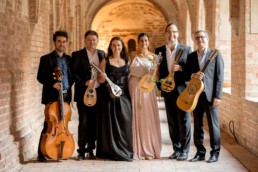
As for the arias recorded here the writing is brilliant, sound and contrasted, in perfect harmony with the tastes of the era. The voice and the mandolin form a dialogue.
These pages are characterized, especially those for mandolin, by their exuberance but also by their delicacy, all in moderation. Here the music is codified, it surprises, fascinates and captivates us. Venice, with its bubbling knowledge surpasses all the other Italian musical centers. The appeal of its spirit, a blend of virtuosity, fervor, theatricality and richness of tones, here the mandolin is in its rightful place.
This Venetian « fragrance » is a wonderful reflection of the unique spirit of the Italian baroque era with its abundant festivities, fireworks, masks, its splendor…
Review
[...] Soprano Nuria Rial brings skill and charm to the arias, delighting both in the way that she sings the music with such style and duets with the obbligato mandolins to create enchanting dialogues. Throughout, the players of Artemandoline perform the music with style and sympathy, accompanying and partnering, whilst also enchanting [...]
Robert Hugill, Planethugill
Sospiri d’amanti
ARTEMANDOLINE & NURIA RIAL
Sospiri d’amanti
Arias & Cantatas
An invitation to the intimate setting of an Austrian or Italian Court at the beginning of the XVIIIth century.
Contrasting voices and instruments performing as a solo or together will compete with charm and impetuosity to conjure up the vivacity and the beauty of the Italian music at the time. In the early years of the 18th century the mandolin was an integral part of the Baroque musical scene. As such, it is found in a hundred or so operas.
Works by:
Caldara, Bononcini, Conti, Händel, Albinoni, Hasse, Gasparini, Paisiello , Galuppi and Mancini.
Performers: 9/10 musicians, violins, mandolins, bc & Nuria Rial, soprano.
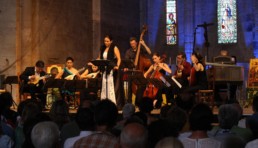
Between 1690 and 1800, the number of songs for voice and mandolin has been put at between 150 and 200. These are arias from operas, oratorios and cantatas as well as songs that were then in fashion. A number of them have been published, but many others exist only in the form of manuscript copies scattered throughout European libraries.
By way of conclusion, we may note that the use of the mandolin in vocal music is an accurate reflection of the aesthetic and historic context of this extraordinarily rich artistic period.
REVIEW
[...] this CD is a jewel of Baroque music. Nuria Rial’s voice perfectly melts with the coloured and sensitive sound of one of the world’s best mandolin baroque ensembles, Artemandoline [...]
Pizzicato Revue, « Supersonic Prize »
Concerti italiani per mandolino
ARTEMANDOLINE
Concerti italiani per mandolino
The program "Concerti italiani per mandolino" will take you to the heart of Naples and the Venice of the 17th and 18th century. The musicians of Artemandoline recreate with taste this atmosphere. The music of the greatest composers is mingled in an infinite rumor in the palaces, the conservatories, the theaters...
Concertos by:
Vivaldi, Hasse, Arrigoni, Paisiello, Giuliano, Barbella, Cecere , Altieri, Caudioso…
Performers: With violins, 10 musicians
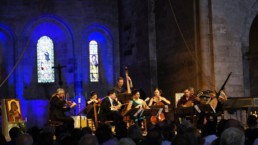
The 18th-century mandolin concertos express the character of the Italian baroque language, where festivals, fireworks, masks, magnificence and extravagance proliferate.
It is the apotheosis of the arts, creation and gigantic events. The celebration is everywhere. From the street to the institutions, art is never partitioned, but always alive.
What constitutes the quintessence of the concerto, is the alternation between the slow and fast movements whose characters and tempi are pushed to the extreme, and finally the great freedom of execution left to the interpreter in phrasing and ornamentation, always at the service of expression, creating the Italian style.
REVIEW
[...] the Luxembourg musicians of Artemandoline have definitely dusted off the music of the seventeenth and eighteenth centuries. They give a new impulse, a new life to the ancient music [...]
Münsterland Festival, Christine Sörries, künstl. Ltg
Festa Veneziana
ARTEMANDOLINE
Festa Veneziana
Sonate & Concerti
No other music had such boundless energy as the music of the Baroque period; it is a hymn to life, to feelings, to emotions, in its search for detail and beauty, eternal beauty. In this programme you will be presented with a huge fresco of life. The baroque period, complex and versatile explored new means of expression, above all, new tone colours. The Baroque musician's curiosity for the most refined sounds, among them, the mandolins, directed their research in favour of an aesthetically pleasing and resounding style.
Works by:
Antonio Vivaldi, concerti.
Dario Castello, sonate.
Ugolino, Uccellini, Arrigoni, Trento, Susier, Piccone, Romaldi, Venier, Sammartini…
Performers: 6/8 musicians.
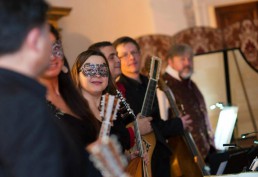
It is in the domain of the concerto that Vivaldi is revealed as a genuine creator by consolidating the tripartite form (fast -slow -fast.) Seduced by the graceful sound of the mandolin, he used it in several of his works. We have heard that among the musicians of l’Ospetale Della Pieta, certain were remarkable mandolin virtuosos. The mandolin concertos of this period clearly reflect the essential character of the Italian baroque, abounding with parties, festivals, firework displays, and masks, in all its magnificence...
REVIEW
[...] a small amount of mandolin music can go a long way, but in the hands of such musicians, a two-hour concert passes quickly for audiences that can appreciate the delicacy of tone provided by such graceful instruments.
Washington Post
Música Mediterránea
ARTEMANDOLINE
Música Mediterránea
Music form Spain and Italy
With this concert we go through two centuries of an eclectic and complex tradition, two centuries of fruitful contrasts, two centuries of Spanish and Neapolitan music. An incredible way of the mandolin through the centuries in the Kingdom of Naples and at the Court of Spain. A rare, original and authentic music.
Arias and works by: Ribayaz, Gaspar Sanz, Domenico Scarlatti, Boccherini, Falconieri, Valente, Santiago de Murcia, Blas de Laserna…
Performers: 6 musicians & Nuria Rial, soprano.
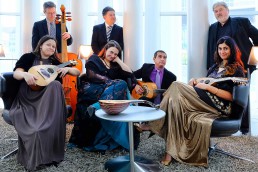
Since the baroque period, the Spanish music has been chanting between the erudite and the popular. Isolated in the peninsula, with a so different history from the rest of the Europe, Spanish baroque music amplifies its possibilities, plays with its "Iberism" and boosts it to be different from the other European countries.
It is on these aspects between cultivated and folkloric tradition that the "copla Española" has been built up to the present day: a musical genre incomparable, unique in Europe. In Spain, it is the profane music that develops the national character from popular forms like the villancicos.
But very soon the Italianism invaded the peninsula from the second half of the seventeenth century except for the sacred music where the innovations of the baroque style will not have immediate access. That said, Spanish music would retain a strong local colour throughout the baroque period.
REVIEW
[...] The ornaments are elegantly chiseled, the text cleverly articulated and the interpretation convincing, even in the lieder of Mozart.
Fono Forum, CD Sospiri d’amanti. Sony
Concerto Imperiale
ARTEMANDOLINE
Concerto Imperiale
Italian music at the court of Austria
Between the end of the 17th century and the beginning of the 18th century, instrumental music experienced an unprecedented artistic bloom. Even to the present day, the immense unexplored original repertoire for mandolin represents a period of transition of vital importance. It is a treasure trove, which deserves to be rediscovered and enhanced. This programme proposes works by well known and lesser-known composers in an attempt to illustrate the main styles and the most significant expressive forms of the period.
Works by: Evaristo Felice dall’Abaco, G. A. Brescianello, G. Cocchi, Conti, Rizzi, Sauli, Schlick, Neuling…
Performers: 6 musicians
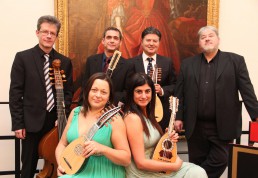
In this way, the purely instrumental music of the mandolin attained a high level of perfection in the 18th century. It was played not only at court in Vienna and in the aristocratic salons, but also among the middle classes in pursuit of culture. This was the golden age of the mandolin, and the refined and intellectual atmosphere of the salons and private residences gave a new artistic direction to the music of the time, revolutionising the taste and sensibilities of a much wider audience.
REVIEW
[...] The ensemble Artemandoline definitely dusts the instrument by bringing it to the pinnacle of virtuosity. This freedom doesn’t contradicts the magic of the pages of Uccellini, Weiss, Scarlatti, Arrigoni, Castello. She sublimes it. A record that can not be missed, as it inspires a joy of living.
François-Xavier Lacroux, France Musique
Luz y norte
ARTEMANDOLINE
Luz y Norte
The specifically instrumental music of the Spanish Baroque, which has survived, constitutes the continuation of the magnificent Renaissance triumvirate of keyboard, harp, and vihuela.
With this concert we go through two centuries of an eclectic and complex tradition, two centuries of fruitful contrasts, two centuries of Spanish and Neapolitan music. An incredible way of the mandolin through the centuries in the Kingdom of Naples and at the Court of Spain. A rare, original and authentic music. An abundant source of manuscripts of the time testifies to this enthusiasm.
Works by: Ribayaz, Gaspar Sanz, Falconieri, Scarlatti, Santiago de Murcia, Boccherini…
Performers : 6/7 musicians.
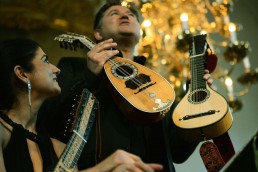
But very soon the Italianism invaded the peninsula from the second half of the seventeenth century except for the sacred music where the innovations of the baroque style will not have immediate access. That said, Spanish music will retain a strong local colour throughout the baroque period.
The mandolin found great success with the nobility and the capitals’ middle classes from 1750 onwards. Many noblemen had their own mandolin teachers and numerous compositions were played all over Europe – in Paris, London, Lisbon, Madrid, Vienna, St Petersburg, Carlsbad and Brussels, for example.
REVIEW
[...] Artemandoline has qualities beyond the technique : the members of the ensemble are musicians up to the tip of their foot and they force admiration. Does not the Vivaldi concerto dazzle us with a perfectly Venetian character? Is not the quartet of C. Stamitz a little jewel thanks to a wonderfully playful game and subtle nuances in colors and dynamics?
Pizzicato Revue. R. Franck.

